Torts 2: Analysis of Business Law and Tort Cases in Canada
VerifiedAdded on 2022/10/18
|6
|2920
|13
Report
AI Summary
This report analyzes three case scenarios within the framework of Canadian tort law. It begins with an introduction to torts, defining them as actions causing harm or injury, and differentiating them from contractual breaches. The report then explores key concepts such as negligence, vicarious liability, and contributory negligence, referencing the "stare decisis doctrine" and its implications. Each case scenario is examined, applying legal principles to determine liability and potential damages. The first case involves a truck driver hitting a pedestrian, with the analysis focusing on the driver's duty of care and negligence. The second scenario involves a truck driver accelerating and causing an accident, with the analysis considering intentional torts like battery and assault, alongside contributory negligence. The third case examines a truck sliding on snow and injuring employees, evaluating the concept of "Act of God" and the applicability of strict liability. The report concludes by applying the business law framework to resolve simple legal issues arising from day-to-day business operations.
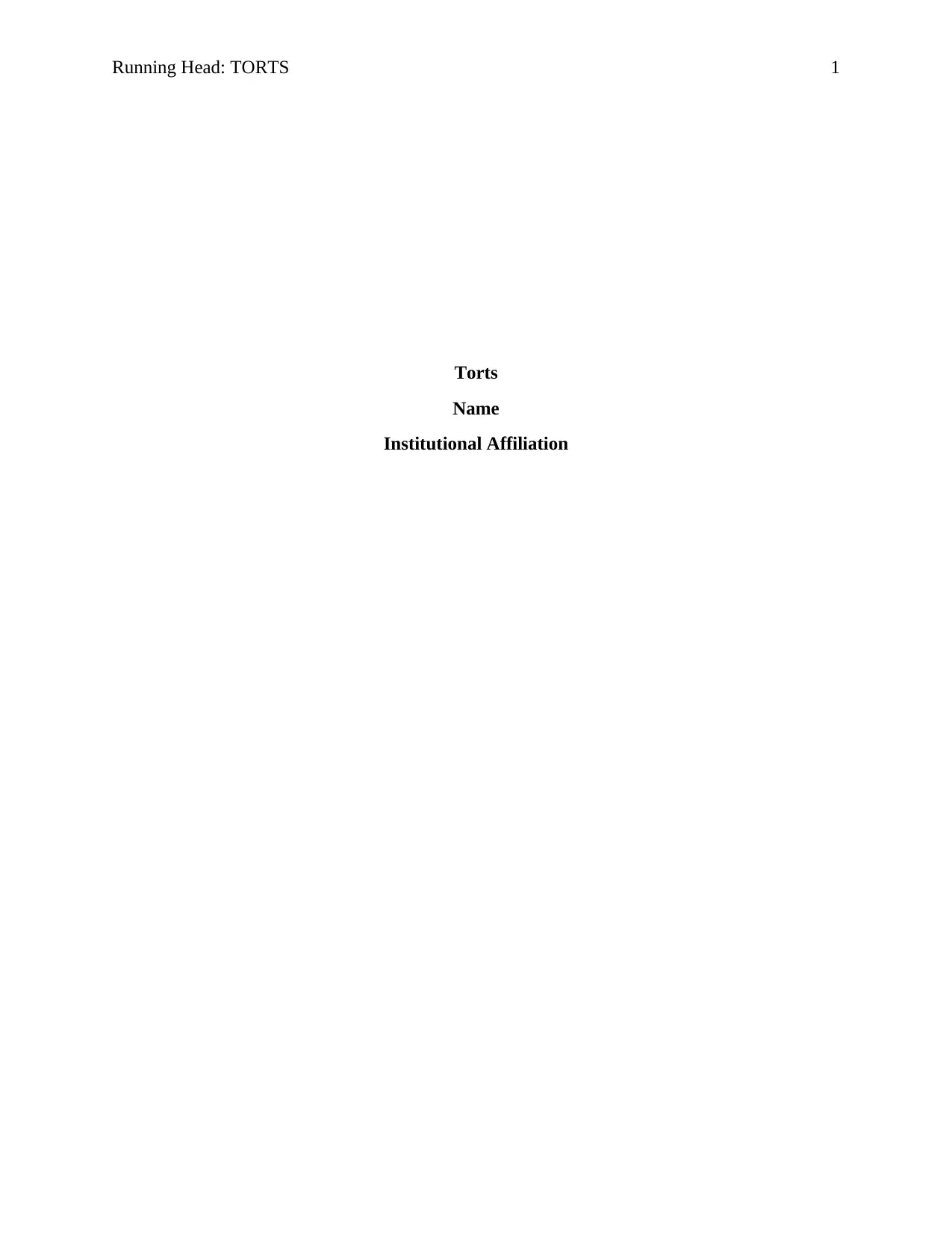
Running Head: TORTS 1
Torts
Name
Institutional Affiliation
Torts
Name
Institutional Affiliation
Paraphrase This Document
Need a fresh take? Get an instant paraphrase of this document with our AI Paraphraser
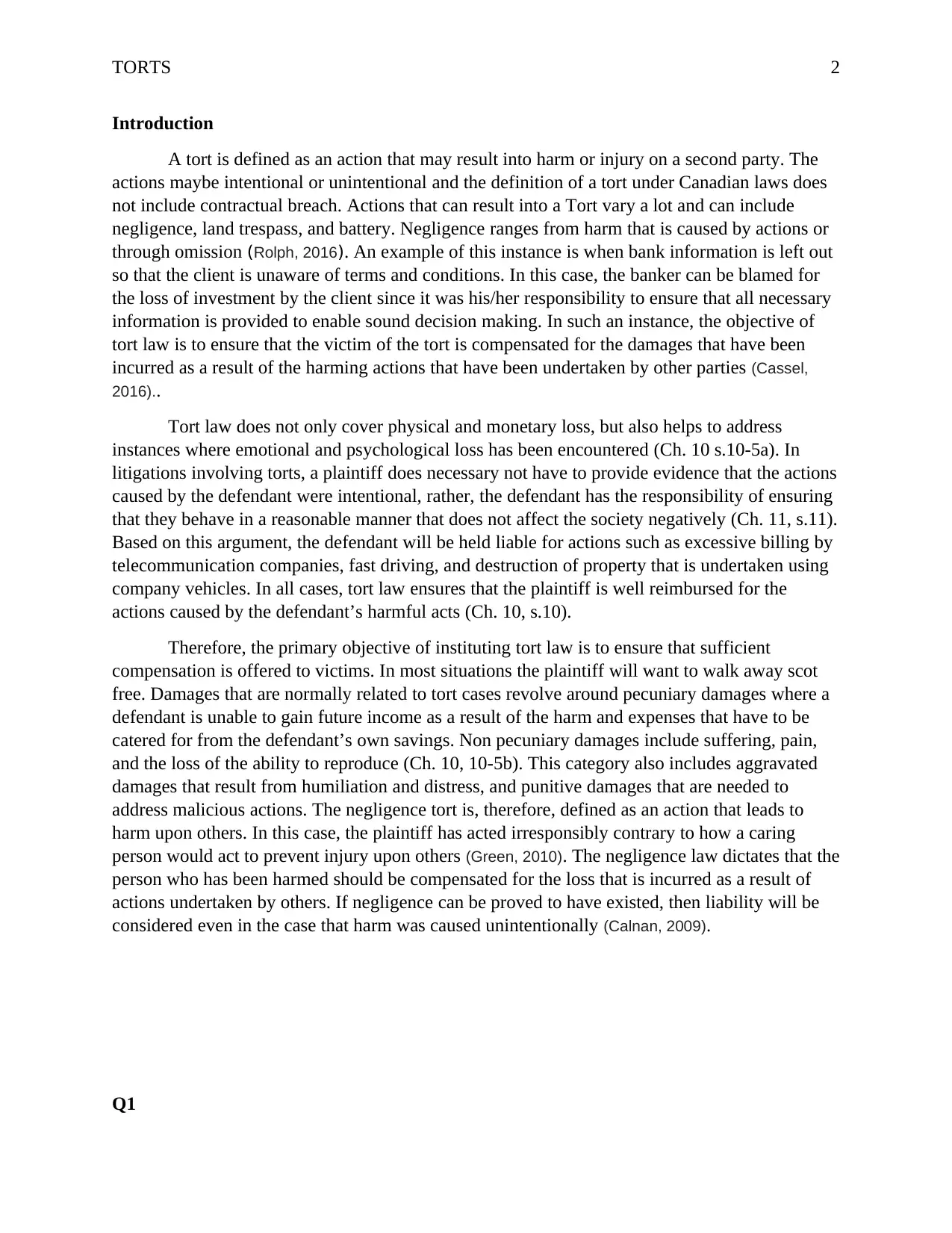
TORTS 2
Introduction
A tort is defined as an action that may result into harm or injury on a second party. The
actions maybe intentional or unintentional and the definition of a tort under Canadian laws does
not include contractual breach. Actions that can result into a Tort vary a lot and can include
negligence, land trespass, and battery. Negligence ranges from harm that is caused by actions or
through omission (Rolph, 2016). An example of this instance is when bank information is left out
so that the client is unaware of terms and conditions. In this case, the banker can be blamed for
the loss of investment by the client since it was his/her responsibility to ensure that all necessary
information is provided to enable sound decision making. In such an instance, the objective of
tort law is to ensure that the victim of the tort is compensated for the damages that have been
incurred as a result of the harming actions that have been undertaken by other parties (Cassel,
2016)..
Tort law does not only cover physical and monetary loss, but also helps to address
instances where emotional and psychological loss has been encountered (Ch. 10 s.10-5a). In
litigations involving torts, a plaintiff does necessary not have to provide evidence that the actions
caused by the defendant were intentional, rather, the defendant has the responsibility of ensuring
that they behave in a reasonable manner that does not affect the society negatively (Ch. 11, s.11).
Based on this argument, the defendant will be held liable for actions such as excessive billing by
telecommunication companies, fast driving, and destruction of property that is undertaken using
company vehicles. In all cases, tort law ensures that the plaintiff is well reimbursed for the
actions caused by the defendant’s harmful acts (Ch. 10, s.10).
Therefore, the primary objective of instituting tort law is to ensure that sufficient
compensation is offered to victims. In most situations the plaintiff will want to walk away scot
free. Damages that are normally related to tort cases revolve around pecuniary damages where a
defendant is unable to gain future income as a result of the harm and expenses that have to be
catered for from the defendant’s own savings. Non pecuniary damages include suffering, pain,
and the loss of the ability to reproduce (Ch. 10, 10-5b). This category also includes aggravated
damages that result from humiliation and distress, and punitive damages that are needed to
address malicious actions. The negligence tort is, therefore, defined as an action that leads to
harm upon others. In this case, the plaintiff has acted irresponsibly contrary to how a caring
person would act to prevent injury upon others (Green, 2010). The negligence law dictates that the
person who has been harmed should be compensated for the loss that is incurred as a result of
actions undertaken by others. If negligence can be proved to have existed, then liability will be
considered even in the case that harm was caused unintentionally (Calnan, 2009).
Q1
Introduction
A tort is defined as an action that may result into harm or injury on a second party. The
actions maybe intentional or unintentional and the definition of a tort under Canadian laws does
not include contractual breach. Actions that can result into a Tort vary a lot and can include
negligence, land trespass, and battery. Negligence ranges from harm that is caused by actions or
through omission (Rolph, 2016). An example of this instance is when bank information is left out
so that the client is unaware of terms and conditions. In this case, the banker can be blamed for
the loss of investment by the client since it was his/her responsibility to ensure that all necessary
information is provided to enable sound decision making. In such an instance, the objective of
tort law is to ensure that the victim of the tort is compensated for the damages that have been
incurred as a result of the harming actions that have been undertaken by other parties (Cassel,
2016)..
Tort law does not only cover physical and monetary loss, but also helps to address
instances where emotional and psychological loss has been encountered (Ch. 10 s.10-5a). In
litigations involving torts, a plaintiff does necessary not have to provide evidence that the actions
caused by the defendant were intentional, rather, the defendant has the responsibility of ensuring
that they behave in a reasonable manner that does not affect the society negatively (Ch. 11, s.11).
Based on this argument, the defendant will be held liable for actions such as excessive billing by
telecommunication companies, fast driving, and destruction of property that is undertaken using
company vehicles. In all cases, tort law ensures that the plaintiff is well reimbursed for the
actions caused by the defendant’s harmful acts (Ch. 10, s.10).
Therefore, the primary objective of instituting tort law is to ensure that sufficient
compensation is offered to victims. In most situations the plaintiff will want to walk away scot
free. Damages that are normally related to tort cases revolve around pecuniary damages where a
defendant is unable to gain future income as a result of the harm and expenses that have to be
catered for from the defendant’s own savings. Non pecuniary damages include suffering, pain,
and the loss of the ability to reproduce (Ch. 10, 10-5b). This category also includes aggravated
damages that result from humiliation and distress, and punitive damages that are needed to
address malicious actions. The negligence tort is, therefore, defined as an action that leads to
harm upon others. In this case, the plaintiff has acted irresponsibly contrary to how a caring
person would act to prevent injury upon others (Green, 2010). The negligence law dictates that the
person who has been harmed should be compensated for the loss that is incurred as a result of
actions undertaken by others. If negligence can be proved to have existed, then liability will be
considered even in the case that harm was caused unintentionally (Calnan, 2009).
Q1
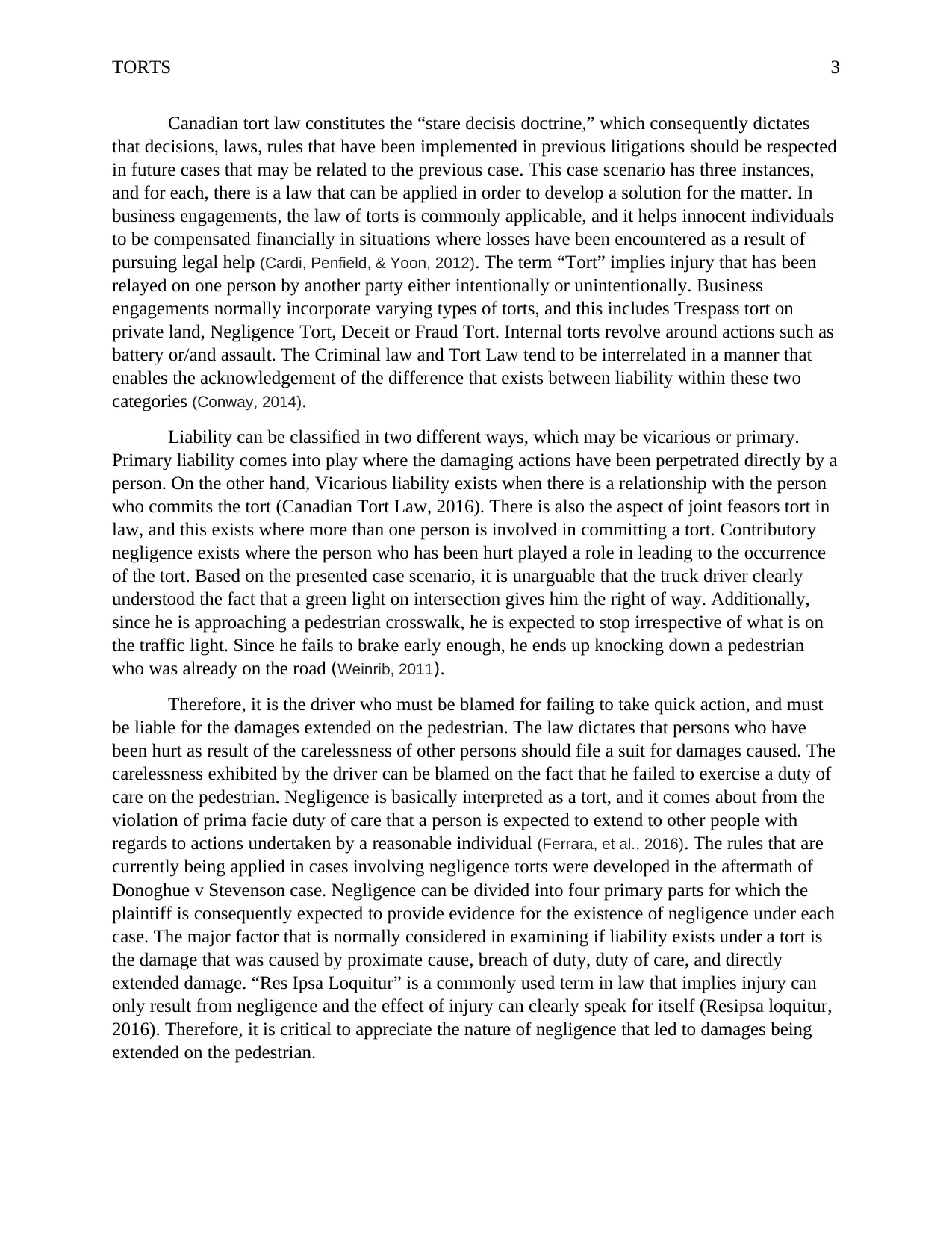
TORTS 3
Canadian tort law constitutes the “stare decisis doctrine,” which consequently dictates
that decisions, laws, rules that have been implemented in previous litigations should be respected
in future cases that may be related to the previous case. This case scenario has three instances,
and for each, there is a law that can be applied in order to develop a solution for the matter. In
business engagements, the law of torts is commonly applicable, and it helps innocent individuals
to be compensated financially in situations where losses have been encountered as a result of
pursuing legal help (Cardi, Penfield, & Yoon, 2012). The term “Tort” implies injury that has been
relayed on one person by another party either intentionally or unintentionally. Business
engagements normally incorporate varying types of torts, and this includes Trespass tort on
private land, Negligence Tort, Deceit or Fraud Tort. Internal torts revolve around actions such as
battery or/and assault. The Criminal law and Tort Law tend to be interrelated in a manner that
enables the acknowledgement of the difference that exists between liability within these two
categories (Conway, 2014).
Liability can be classified in two different ways, which may be vicarious or primary.
Primary liability comes into play where the damaging actions have been perpetrated directly by a
person. On the other hand, Vicarious liability exists when there is a relationship with the person
who commits the tort (Canadian Tort Law, 2016). There is also the aspect of joint feasors tort in
law, and this exists where more than one person is involved in committing a tort. Contributory
negligence exists where the person who has been hurt played a role in leading to the occurrence
of the tort. Based on the presented case scenario, it is unarguable that the truck driver clearly
understood the fact that a green light on intersection gives him the right of way. Additionally,
since he is approaching a pedestrian crosswalk, he is expected to stop irrespective of what is on
the traffic light. Since he fails to brake early enough, he ends up knocking down a pedestrian
who was already on the road (Weinrib, 2011).
Therefore, it is the driver who must be blamed for failing to take quick action, and must
be liable for the damages extended on the pedestrian. The law dictates that persons who have
been hurt as result of the carelessness of other persons should file a suit for damages caused. The
carelessness exhibited by the driver can be blamed on the fact that he failed to exercise a duty of
care on the pedestrian. Negligence is basically interpreted as a tort, and it comes about from the
violation of prima facie duty of care that a person is expected to extend to other people with
regards to actions undertaken by a reasonable individual (Ferrara, et al., 2016). The rules that are
currently being applied in cases involving negligence torts were developed in the aftermath of
Donoghue v Stevenson case. Negligence can be divided into four primary parts for which the
plaintiff is consequently expected to provide evidence for the existence of negligence under each
case. The major factor that is normally considered in examining if liability exists under a tort is
the damage that was caused by proximate cause, breach of duty, duty of care, and directly
extended damage. “Res Ipsa Loquitur” is a commonly used term in law that implies injury can
only result from negligence and the effect of injury can clearly speak for itself (Resipsa loquitur,
2016). Therefore, it is critical to appreciate the nature of negligence that led to damages being
extended on the pedestrian.
Canadian tort law constitutes the “stare decisis doctrine,” which consequently dictates
that decisions, laws, rules that have been implemented in previous litigations should be respected
in future cases that may be related to the previous case. This case scenario has three instances,
and for each, there is a law that can be applied in order to develop a solution for the matter. In
business engagements, the law of torts is commonly applicable, and it helps innocent individuals
to be compensated financially in situations where losses have been encountered as a result of
pursuing legal help (Cardi, Penfield, & Yoon, 2012). The term “Tort” implies injury that has been
relayed on one person by another party either intentionally or unintentionally. Business
engagements normally incorporate varying types of torts, and this includes Trespass tort on
private land, Negligence Tort, Deceit or Fraud Tort. Internal torts revolve around actions such as
battery or/and assault. The Criminal law and Tort Law tend to be interrelated in a manner that
enables the acknowledgement of the difference that exists between liability within these two
categories (Conway, 2014).
Liability can be classified in two different ways, which may be vicarious or primary.
Primary liability comes into play where the damaging actions have been perpetrated directly by a
person. On the other hand, Vicarious liability exists when there is a relationship with the person
who commits the tort (Canadian Tort Law, 2016). There is also the aspect of joint feasors tort in
law, and this exists where more than one person is involved in committing a tort. Contributory
negligence exists where the person who has been hurt played a role in leading to the occurrence
of the tort. Based on the presented case scenario, it is unarguable that the truck driver clearly
understood the fact that a green light on intersection gives him the right of way. Additionally,
since he is approaching a pedestrian crosswalk, he is expected to stop irrespective of what is on
the traffic light. Since he fails to brake early enough, he ends up knocking down a pedestrian
who was already on the road (Weinrib, 2011).
Therefore, it is the driver who must be blamed for failing to take quick action, and must
be liable for the damages extended on the pedestrian. The law dictates that persons who have
been hurt as result of the carelessness of other persons should file a suit for damages caused. The
carelessness exhibited by the driver can be blamed on the fact that he failed to exercise a duty of
care on the pedestrian. Negligence is basically interpreted as a tort, and it comes about from the
violation of prima facie duty of care that a person is expected to extend to other people with
regards to actions undertaken by a reasonable individual (Ferrara, et al., 2016). The rules that are
currently being applied in cases involving negligence torts were developed in the aftermath of
Donoghue v Stevenson case. Negligence can be divided into four primary parts for which the
plaintiff is consequently expected to provide evidence for the existence of negligence under each
case. The major factor that is normally considered in examining if liability exists under a tort is
the damage that was caused by proximate cause, breach of duty, duty of care, and directly
extended damage. “Res Ipsa Loquitur” is a commonly used term in law that implies injury can
only result from negligence and the effect of injury can clearly speak for itself (Resipsa loquitur,
2016). Therefore, it is critical to appreciate the nature of negligence that led to damages being
extended on the pedestrian.
⊘ This is a preview!⊘
Do you want full access?
Subscribe today to unlock all pages.

Trusted by 1+ million students worldwide
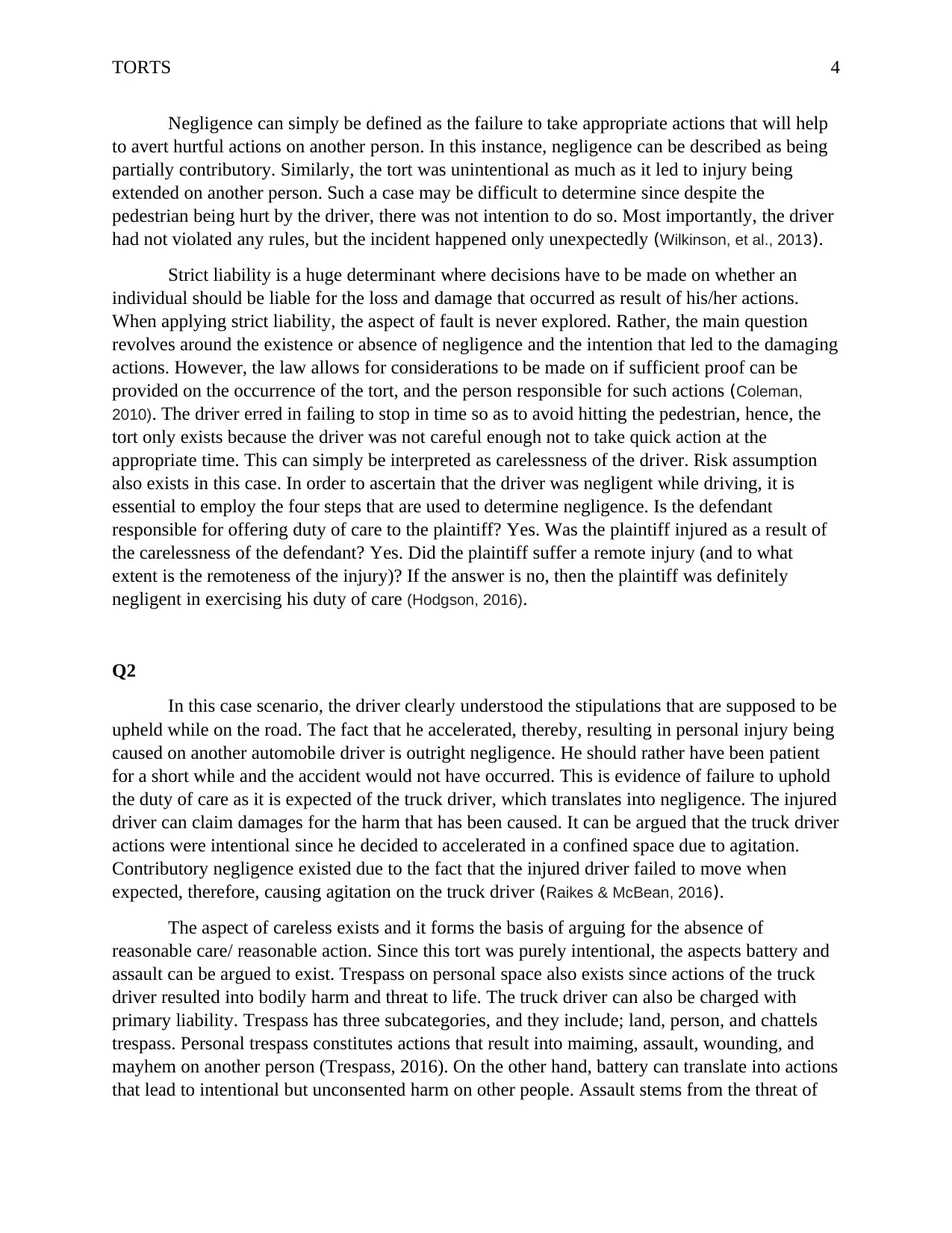
TORTS 4
Negligence can simply be defined as the failure to take appropriate actions that will help
to avert hurtful actions on another person. In this instance, negligence can be described as being
partially contributory. Similarly, the tort was unintentional as much as it led to injury being
extended on another person. Such a case may be difficult to determine since despite the
pedestrian being hurt by the driver, there was not intention to do so. Most importantly, the driver
had not violated any rules, but the incident happened only unexpectedly (Wilkinson, et al., 2013).
Strict liability is a huge determinant where decisions have to be made on whether an
individual should be liable for the loss and damage that occurred as result of his/her actions.
When applying strict liability, the aspect of fault is never explored. Rather, the main question
revolves around the existence or absence of negligence and the intention that led to the damaging
actions. However, the law allows for considerations to be made on if sufficient proof can be
provided on the occurrence of the tort, and the person responsible for such actions (Coleman,
2010). The driver erred in failing to stop in time so as to avoid hitting the pedestrian, hence, the
tort only exists because the driver was not careful enough not to take quick action at the
appropriate time. This can simply be interpreted as carelessness of the driver. Risk assumption
also exists in this case. In order to ascertain that the driver was negligent while driving, it is
essential to employ the four steps that are used to determine negligence. Is the defendant
responsible for offering duty of care to the plaintiff? Yes. Was the plaintiff injured as a result of
the carelessness of the defendant? Yes. Did the plaintiff suffer a remote injury (and to what
extent is the remoteness of the injury)? If the answer is no, then the plaintiff was definitely
negligent in exercising his duty of care (Hodgson, 2016).
Q2
In this case scenario, the driver clearly understood the stipulations that are supposed to be
upheld while on the road. The fact that he accelerated, thereby, resulting in personal injury being
caused on another automobile driver is outright negligence. He should rather have been patient
for a short while and the accident would not have occurred. This is evidence of failure to uphold
the duty of care as it is expected of the truck driver, which translates into negligence. The injured
driver can claim damages for the harm that has been caused. It can be argued that the truck driver
actions were intentional since he decided to accelerated in a confined space due to agitation.
Contributory negligence existed due to the fact that the injured driver failed to move when
expected, therefore, causing agitation on the truck driver (Raikes & McBean, 2016).
The aspect of careless exists and it forms the basis of arguing for the absence of
reasonable care/ reasonable action. Since this tort was purely intentional, the aspects battery and
assault can be argued to exist. Trespass on personal space also exists since actions of the truck
driver resulted into bodily harm and threat to life. The truck driver can also be charged with
primary liability. Trespass has three subcategories, and they include; land, person, and chattels
trespass. Personal trespass constitutes actions that result into maiming, assault, wounding, and
mayhem on another person (Trespass, 2016). On the other hand, battery can translate into actions
that lead to intentional but unconsented harm on other people. Assault stems from the threat of
Negligence can simply be defined as the failure to take appropriate actions that will help
to avert hurtful actions on another person. In this instance, negligence can be described as being
partially contributory. Similarly, the tort was unintentional as much as it led to injury being
extended on another person. Such a case may be difficult to determine since despite the
pedestrian being hurt by the driver, there was not intention to do so. Most importantly, the driver
had not violated any rules, but the incident happened only unexpectedly (Wilkinson, et al., 2013).
Strict liability is a huge determinant where decisions have to be made on whether an
individual should be liable for the loss and damage that occurred as result of his/her actions.
When applying strict liability, the aspect of fault is never explored. Rather, the main question
revolves around the existence or absence of negligence and the intention that led to the damaging
actions. However, the law allows for considerations to be made on if sufficient proof can be
provided on the occurrence of the tort, and the person responsible for such actions (Coleman,
2010). The driver erred in failing to stop in time so as to avoid hitting the pedestrian, hence, the
tort only exists because the driver was not careful enough not to take quick action at the
appropriate time. This can simply be interpreted as carelessness of the driver. Risk assumption
also exists in this case. In order to ascertain that the driver was negligent while driving, it is
essential to employ the four steps that are used to determine negligence. Is the defendant
responsible for offering duty of care to the plaintiff? Yes. Was the plaintiff injured as a result of
the carelessness of the defendant? Yes. Did the plaintiff suffer a remote injury (and to what
extent is the remoteness of the injury)? If the answer is no, then the plaintiff was definitely
negligent in exercising his duty of care (Hodgson, 2016).
Q2
In this case scenario, the driver clearly understood the stipulations that are supposed to be
upheld while on the road. The fact that he accelerated, thereby, resulting in personal injury being
caused on another automobile driver is outright negligence. He should rather have been patient
for a short while and the accident would not have occurred. This is evidence of failure to uphold
the duty of care as it is expected of the truck driver, which translates into negligence. The injured
driver can claim damages for the harm that has been caused. It can be argued that the truck driver
actions were intentional since he decided to accelerated in a confined space due to agitation.
Contributory negligence existed due to the fact that the injured driver failed to move when
expected, therefore, causing agitation on the truck driver (Raikes & McBean, 2016).
The aspect of careless exists and it forms the basis of arguing for the absence of
reasonable care/ reasonable action. Since this tort was purely intentional, the aspects battery and
assault can be argued to exist. Trespass on personal space also exists since actions of the truck
driver resulted into bodily harm and threat to life. The truck driver can also be charged with
primary liability. Trespass has three subcategories, and they include; land, person, and chattels
trespass. Personal trespass constitutes actions that result into maiming, assault, wounding, and
mayhem on another person (Trespass, 2016). On the other hand, battery can translate into actions
that lead to intentional but unconsented harm on other people. Assault stems from the threat of
Paraphrase This Document
Need a fresh take? Get an instant paraphrase of this document with our AI Paraphraser
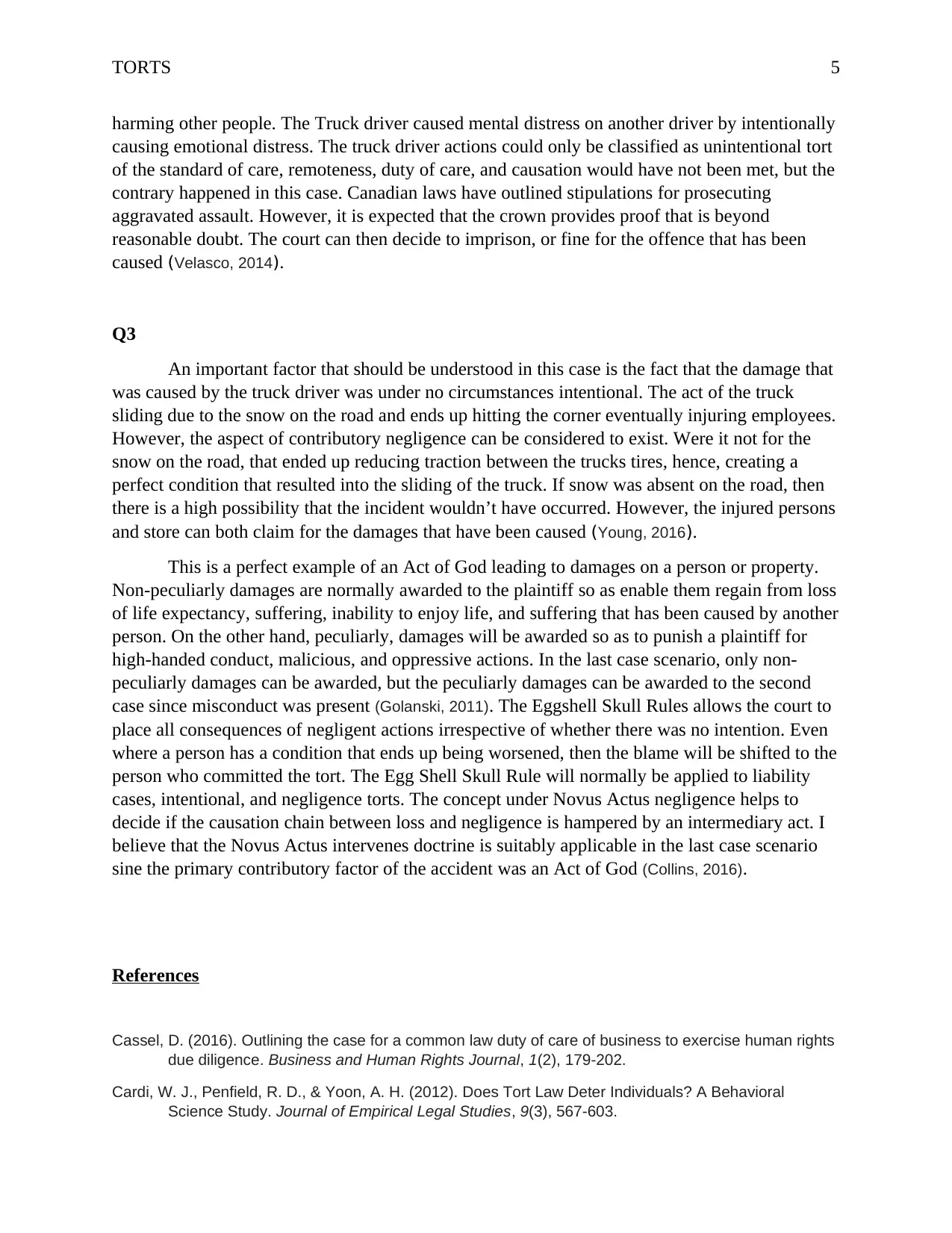
TORTS 5
harming other people. The Truck driver caused mental distress on another driver by intentionally
causing emotional distress. The truck driver actions could only be classified as unintentional tort
of the standard of care, remoteness, duty of care, and causation would have not been met, but the
contrary happened in this case. Canadian laws have outlined stipulations for prosecuting
aggravated assault. However, it is expected that the crown provides proof that is beyond
reasonable doubt. The court can then decide to imprison, or fine for the offence that has been
caused (Velasco, 2014).
Q3
An important factor that should be understood in this case is the fact that the damage that
was caused by the truck driver was under no circumstances intentional. The act of the truck
sliding due to the snow on the road and ends up hitting the corner eventually injuring employees.
However, the aspect of contributory negligence can be considered to exist. Were it not for the
snow on the road, that ended up reducing traction between the trucks tires, hence, creating a
perfect condition that resulted into the sliding of the truck. If snow was absent on the road, then
there is a high possibility that the incident wouldn’t have occurred. However, the injured persons
and store can both claim for the damages that have been caused (Young, 2016).
This is a perfect example of an Act of God leading to damages on a person or property.
Non-peculiarly damages are normally awarded to the plaintiff so as enable them regain from loss
of life expectancy, suffering, inability to enjoy life, and suffering that has been caused by another
person. On the other hand, peculiarly, damages will be awarded so as to punish a plaintiff for
high-handed conduct, malicious, and oppressive actions. In the last case scenario, only non-
peculiarly damages can be awarded, but the peculiarly damages can be awarded to the second
case since misconduct was present (Golanski, 2011). The Eggshell Skull Rules allows the court to
place all consequences of negligent actions irrespective of whether there was no intention. Even
where a person has a condition that ends up being worsened, then the blame will be shifted to the
person who committed the tort. The Egg Shell Skull Rule will normally be applied to liability
cases, intentional, and negligence torts. The concept under Novus Actus negligence helps to
decide if the causation chain between loss and negligence is hampered by an intermediary act. I
believe that the Novus Actus intervenes doctrine is suitably applicable in the last case scenario
sine the primary contributory factor of the accident was an Act of God (Collins, 2016).
References
Cassel, D. (2016). Outlining the case for a common law duty of care of business to exercise human rights
due diligence. Business and Human Rights Journal, 1(2), 179-202.
Cardi, W. J., Penfield, R. D., & Yoon, A. H. (2012). Does Tort Law Deter Individuals? A Behavioral
Science Study. Journal of Empirical Legal Studies, 9(3), 567-603.
harming other people. The Truck driver caused mental distress on another driver by intentionally
causing emotional distress. The truck driver actions could only be classified as unintentional tort
of the standard of care, remoteness, duty of care, and causation would have not been met, but the
contrary happened in this case. Canadian laws have outlined stipulations for prosecuting
aggravated assault. However, it is expected that the crown provides proof that is beyond
reasonable doubt. The court can then decide to imprison, or fine for the offence that has been
caused (Velasco, 2014).
Q3
An important factor that should be understood in this case is the fact that the damage that
was caused by the truck driver was under no circumstances intentional. The act of the truck
sliding due to the snow on the road and ends up hitting the corner eventually injuring employees.
However, the aspect of contributory negligence can be considered to exist. Were it not for the
snow on the road, that ended up reducing traction between the trucks tires, hence, creating a
perfect condition that resulted into the sliding of the truck. If snow was absent on the road, then
there is a high possibility that the incident wouldn’t have occurred. However, the injured persons
and store can both claim for the damages that have been caused (Young, 2016).
This is a perfect example of an Act of God leading to damages on a person or property.
Non-peculiarly damages are normally awarded to the plaintiff so as enable them regain from loss
of life expectancy, suffering, inability to enjoy life, and suffering that has been caused by another
person. On the other hand, peculiarly, damages will be awarded so as to punish a plaintiff for
high-handed conduct, malicious, and oppressive actions. In the last case scenario, only non-
peculiarly damages can be awarded, but the peculiarly damages can be awarded to the second
case since misconduct was present (Golanski, 2011). The Eggshell Skull Rules allows the court to
place all consequences of negligent actions irrespective of whether there was no intention. Even
where a person has a condition that ends up being worsened, then the blame will be shifted to the
person who committed the tort. The Egg Shell Skull Rule will normally be applied to liability
cases, intentional, and negligence torts. The concept under Novus Actus negligence helps to
decide if the causation chain between loss and negligence is hampered by an intermediary act. I
believe that the Novus Actus intervenes doctrine is suitably applicable in the last case scenario
sine the primary contributory factor of the accident was an Act of God (Collins, 2016).
References
Cassel, D. (2016). Outlining the case for a common law duty of care of business to exercise human rights
due diligence. Business and Human Rights Journal, 1(2), 179-202.
Cardi, W. J., Penfield, R. D., & Yoon, A. H. (2012). Does Tort Law Deter Individuals? A Behavioral
Science Study. Journal of Empirical Legal Studies, 9(3), 567-603.
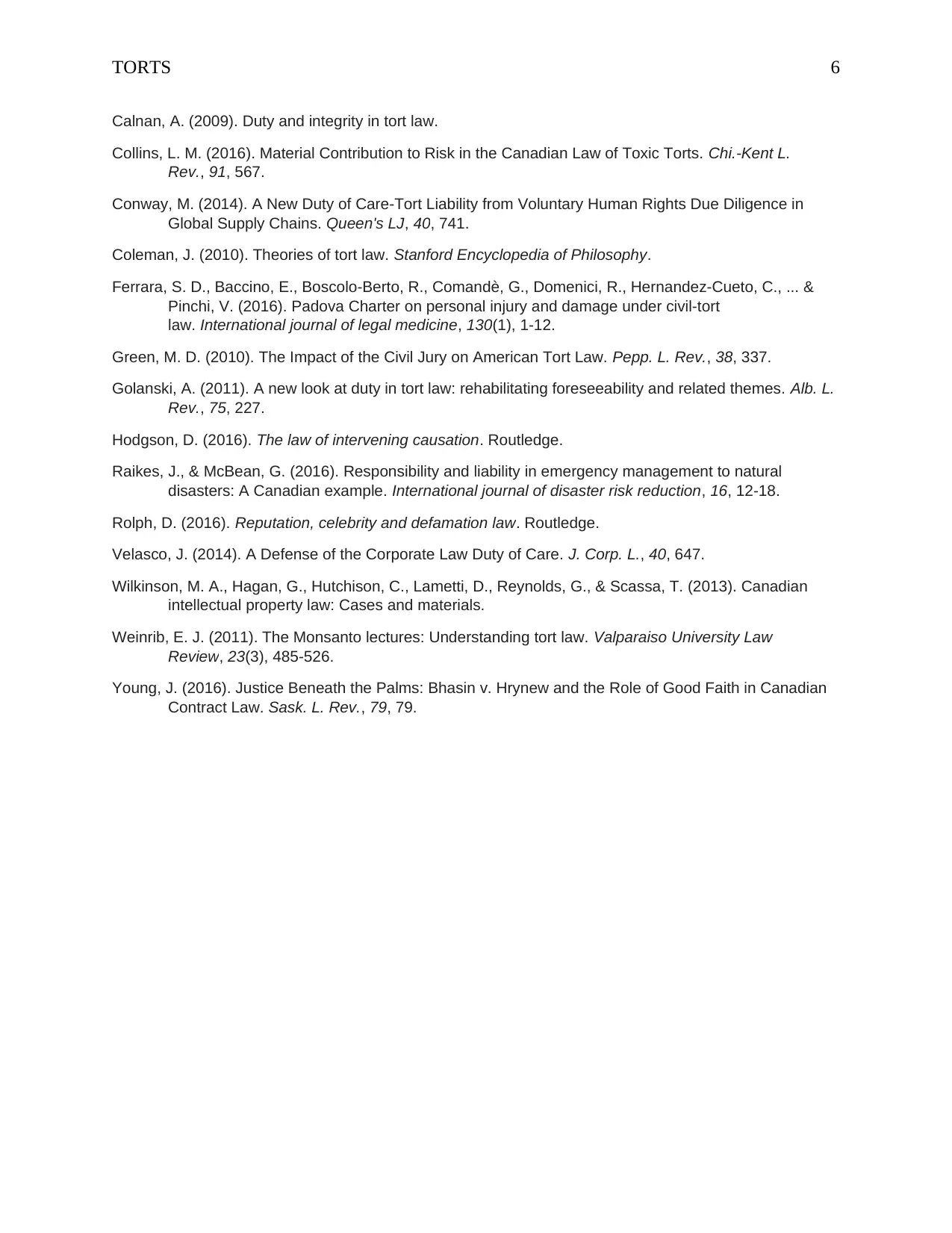
TORTS 6
Calnan, A. (2009). Duty and integrity in tort law.
Collins, L. M. (2016). Material Contribution to Risk in the Canadian Law of Toxic Torts. Chi.-Kent L.
Rev., 91, 567.
Conway, M. (2014). A New Duty of Care-Tort Liability from Voluntary Human Rights Due Diligence in
Global Supply Chains. Queen's LJ, 40, 741.
Coleman, J. (2010). Theories of tort law. Stanford Encyclopedia of Philosophy.
Ferrara, S. D., Baccino, E., Boscolo-Berto, R., Comandè, G., Domenici, R., Hernandez-Cueto, C., ... &
Pinchi, V. (2016). Padova Charter on personal injury and damage under civil-tort
law. International journal of legal medicine, 130(1), 1-12.
Green, M. D. (2010). The Impact of the Civil Jury on American Tort Law. Pepp. L. Rev., 38, 337.
Golanski, A. (2011). A new look at duty in tort law: rehabilitating foreseeability and related themes. Alb. L.
Rev., 75, 227.
Hodgson, D. (2016). The law of intervening causation. Routledge.
Raikes, J., & McBean, G. (2016). Responsibility and liability in emergency management to natural
disasters: A Canadian example. International journal of disaster risk reduction, 16, 12-18.
Rolph, D. (2016). Reputation, celebrity and defamation law. Routledge.
Velasco, J. (2014). A Defense of the Corporate Law Duty of Care. J. Corp. L., 40, 647.
Wilkinson, M. A., Hagan, G., Hutchison, C., Lametti, D., Reynolds, G., & Scassa, T. (2013). Canadian
intellectual property law: Cases and materials.
Weinrib, E. J. (2011). The Monsanto lectures: Understanding tort law. Valparaiso University Law
Review, 23(3), 485-526.
Young, J. (2016). Justice Beneath the Palms: Bhasin v. Hrynew and the Role of Good Faith in Canadian
Contract Law. Sask. L. Rev., 79, 79.
Calnan, A. (2009). Duty and integrity in tort law.
Collins, L. M. (2016). Material Contribution to Risk in the Canadian Law of Toxic Torts. Chi.-Kent L.
Rev., 91, 567.
Conway, M. (2014). A New Duty of Care-Tort Liability from Voluntary Human Rights Due Diligence in
Global Supply Chains. Queen's LJ, 40, 741.
Coleman, J. (2010). Theories of tort law. Stanford Encyclopedia of Philosophy.
Ferrara, S. D., Baccino, E., Boscolo-Berto, R., Comandè, G., Domenici, R., Hernandez-Cueto, C., ... &
Pinchi, V. (2016). Padova Charter on personal injury and damage under civil-tort
law. International journal of legal medicine, 130(1), 1-12.
Green, M. D. (2010). The Impact of the Civil Jury on American Tort Law. Pepp. L. Rev., 38, 337.
Golanski, A. (2011). A new look at duty in tort law: rehabilitating foreseeability and related themes. Alb. L.
Rev., 75, 227.
Hodgson, D. (2016). The law of intervening causation. Routledge.
Raikes, J., & McBean, G. (2016). Responsibility and liability in emergency management to natural
disasters: A Canadian example. International journal of disaster risk reduction, 16, 12-18.
Rolph, D. (2016). Reputation, celebrity and defamation law. Routledge.
Velasco, J. (2014). A Defense of the Corporate Law Duty of Care. J. Corp. L., 40, 647.
Wilkinson, M. A., Hagan, G., Hutchison, C., Lametti, D., Reynolds, G., & Scassa, T. (2013). Canadian
intellectual property law: Cases and materials.
Weinrib, E. J. (2011). The Monsanto lectures: Understanding tort law. Valparaiso University Law
Review, 23(3), 485-526.
Young, J. (2016). Justice Beneath the Palms: Bhasin v. Hrynew and the Role of Good Faith in Canadian
Contract Law. Sask. L. Rev., 79, 79.
⊘ This is a preview!⊘
Do you want full access?
Subscribe today to unlock all pages.

Trusted by 1+ million students worldwide
1 out of 6
Related Documents
Your All-in-One AI-Powered Toolkit for Academic Success.
+13062052269
info@desklib.com
Available 24*7 on WhatsApp / Email
![[object Object]](/_next/static/media/star-bottom.7253800d.svg)
Unlock your academic potential
Copyright © 2020–2025 A2Z Services. All Rights Reserved. Developed and managed by ZUCOL.




![Detailed Case Note: ABC v Lenah Game Meats Pty Ltd [2001] HCA 63 - Law](/_next/image/?url=https%3A%2F%2Fdesklib.com%2Fmedia%2Fimages%2Fun%2F2defe8bc0fc343dd9dabacb72abf0ae7.jpg&w=256&q=75)
